Long Runway, Small Plane, Big Sky
When these headwaters pilots feel the urge to fly, they step out their back door.
In the late 1950s, a boy stood in a Brampton backyard, looking up. Puzzled. That boy was a young Stan Vander Ploeg.
“I kept seeing little airplanes flying overhead. From time to time, the engine would quit right above my head and I’d think, ‘Oh-oh, that guy’s in trouble!’ And he’d glide off out of sight. Then another son-of-a-gun had his engine quit, same spot, right above me! I had to chase these airplanes!”
Stan is much older now and living in Grand Valley. But he’s still looking up and is grateful for what he saw back then – and where it led him. “The romance of flight. It hasn’t changed. I have the same ache to go flying. To leave the earth for a while. It is a lifelong love.”
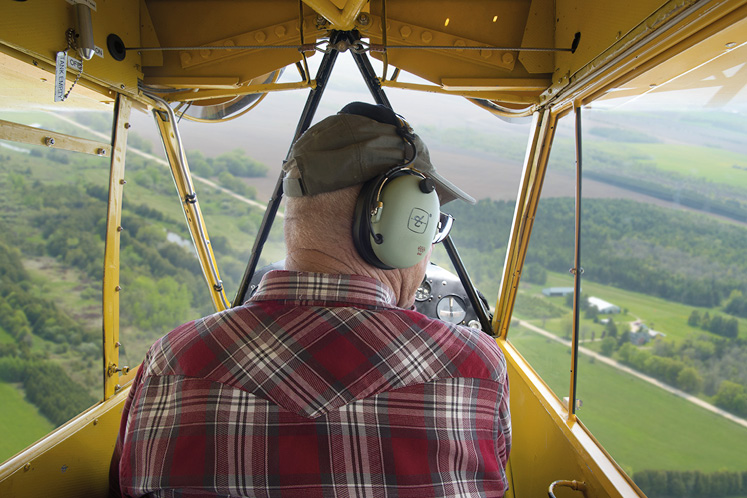
Stan Vander Ploeg takes in the view above his airfield in Grand Valley. Photography by Pete Paterson.
Young Stan tracked those “stricken” aircraft to the nearby Brampton Flying Club, walked boldly in and said hello. (Turns out the “faltering” planes, engines throttled back on purpose, were part of pilots’ training to land.)
He started dropping by the club two or three times a week after school. At first he gawked. Later he cleaned windshields and washed planes. At 13, he was pumping aviation fuel. “You won’t see that today!” The first time the eager kid was taken aloft and saw the ground fall away beneath him, he was hooked. “Jeez, I’ve got to do this!” he thought. “I’ve just got to do this!”
And so he has, for 57 years, a licensed pilot since the age of 17. He flies a yellow Piper J-3 Cub with registration CF-WFT painted on the sides of the fuselage and in big letters on the underside of one wing and the top of the other, in accordance with the vintage of the plane.
Stan, now retired from a career as an Air Canada aircraft maintenance engineer, and his wife, Sheila – the two met at an airport – operate Grand Valley Aircraft Restoration on their rural property. There they have painstakingly restored every part of vintage aircraft from propeller to tail. The turf airstrip they created, Grand Valley North Aerodrome, designated CGV3 by Transport Canada, has been the couple’s backyard for two decades.
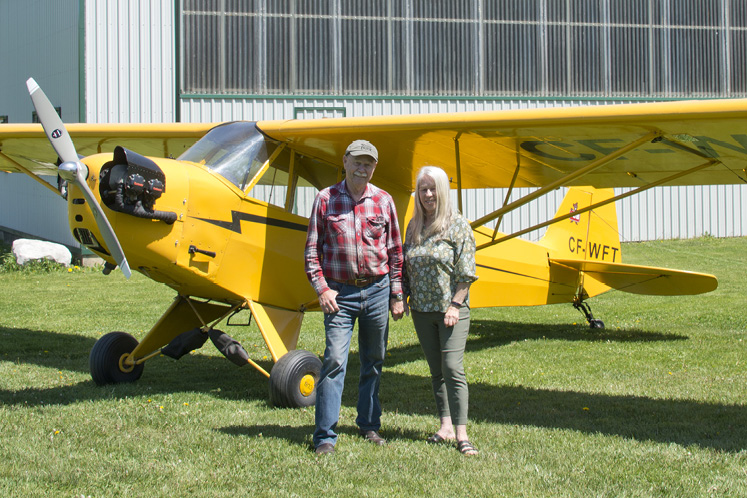
Stan and Sheila Vander Ploeg with their Piper J-3 Cub outside the hangar at Grand Valley North Aerodomes on their rural property.
The flight paths of private rural airfields like the Vander Ploegs’ may not, by regulation, overfly the dwelling of an existing neighbour. But if an airstrip exists and a new neighbour arrives to complain or plan construction, the airfield usually takes precedence – even if the neighbour is a company with plans to build big, fancy wind turbines that generate power to feed into Ontario’s electrical grid.
“There were going to be wind turbines just north of where our runway was going to be,” Stan remembers. “None of them was built yet, of course, just a thought put out, a possibility. They would have known about us. We’d already cut trees. They got upset. ‘Wait a minute, this is not an airport!’ they said. I said, ‘Well yes, it is. I’ve already started. My runway is underway. We were first.’” He notes that Transport Canada’s approval of the construction plan bolstered his case.
“There was a bit of a skirmish, nothing serious, but they cancelled four wind turbines,” he adds. “More people were happy about that than unhappy.”
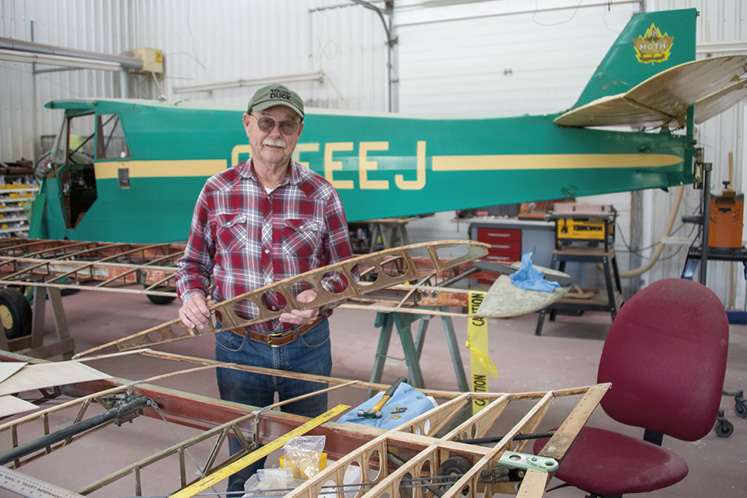
Through their business, Grand Valley Aircraft Restoration, Stan and Sheila have restored every part of vintage aircraft from propeller to tail.
“I haven’t heard of any private airfield up here having problems with neighbours in 30 years,” says Paul Lamont. He lives on Cedar Strip Farm in Amaranth and flies his Maule M5-210C, from Laurel/Whittington Aerodrome (CLW3). “There’s not any great traffic into these strips. I might have a dozen people in a year. Motorcyclists on the road make more noise.”
Stan, Paul and their fellow aviators are a sociable group. The dozen or so local airfields – unless posted PNR (prior notification required) in aviators’ handbooks – are open and free for any pilot to drop into (literally) for a visit, though that hospitality isn’t overtaxed. Maybe a couple of planes a month fly in “to borrow some tools or have a cup of coffee” with Stan and Sheila. “As a group we’re anxious to see people, see their planes,” says Stan. “There is no association but 90 per cent of us know one another. We’ve never been turned away elsewhere.”
In search of the $100 hamburger
The “$100 hamburger” is a standing joke among private pilots. They will, on a whim, a hankering for a burger and a beckoning balmy day, fly out to a near-ish airfield to hobnob with peers around a barbecue. Factoring in the cost of aviation fuel – approaching $2.80 a litre as of spring 2023 – as well as wear and tear on their aircraft, an hour’s return flight in a Piper Cub like Stan’s to, say, Collingwood, will set them back about $100.
If the sound of a $100 hamburger – and the attendant joys of flying your own aircraft to enjoy it – appeals, just what will it take to get you off the ground?
Training. To earn a private pilot licence, or PPL, through a Transport Canada-approved training facility such as the Brampton Flight Centre in Caledon, the learning curve is steep, as is the price.
Basic flight training for a single-engine aircraft runs about $12,000. But a budget of $15,000 to $18,000 is more realistic, according to Scott Chayko, chief flight instructor at BFC, located south of Inglewood. Training and costs can be spread “self-paced” over months or even years.
Transport Canada mandates 40 hours of classroom study or “ground school,” which covers topics such as weather, air law, aircraft construction and engine systems, as well as a minimum of 45 hours in the air. The 45 hours of air time is theoretical, says Scott. “Count on more,” he advises. “The average is around 70 hours.” It takes about a year to achieve the level of competence necessary to become a licensed private pilot.
Scott suggests the experience is worth it. “Flying is an exciting thing. It is a calling, a passion. Every time I go up, I feel it.”
An airfield. Creating a glorified long lawn – the Vander Ploegs’ airstrip measures 2,000 x 75 feet – on suitable property, entails planning and work. You’ll need flat land. A brushy field is preferable (land suitable for crops or pasturing cattle is expensive). A bulldozed, rolled and specially seeded bare-bones airstrip might set you back about ten grand.
An aircraft. The starter plane is a Cessna 150. If you’re seeking a showroom-shiny one, you won’t find it. Cessna stopped making them in 1977. For well-maintained used examples (found on the internet or in the back pages of aviation magazines), set aside about 50 grand.
Insurance. Liability coverage will cost between $500 and $700 annually. This doesn’t include “hull insurance,” the equivalent of collision insurance for a car, which covers damage to the hull or engine, and runs about $3,000 a year.
Repairing light damage from a heavy runway landing might cost between $8,000 and $10,000. Damage from a propeller “strike” (overapplying the throttle, causing a taxiing plane to tip on its nose, for example) will entail not only an expensive propeller replacement, but also – by Transport Canada rules – removal and X-ray of the crankshaft, replacement of damaged parts, and reassembly of the entire engine. Think $25,000-plus.
Operating costs. With fuel, oil and maintenance you do yourself, plan on a cost of at least $100 an hour for time both on the ground and in the air.
Flying for delight
John Black is a flyer and a farmer who tends 200 acres of wheat, corn and soy in East Garafraxa. He built Black Field (CGV5) airstrip on his property south of Grand Valley in 1979.
At a plowing match in Breslau, near Kitchener, when John was 15 or so, his father coaxed him into taking a flight. “That was the last time I had to be coaxed into an airplane,” says John, who earned his pilot’s licence in 1971.
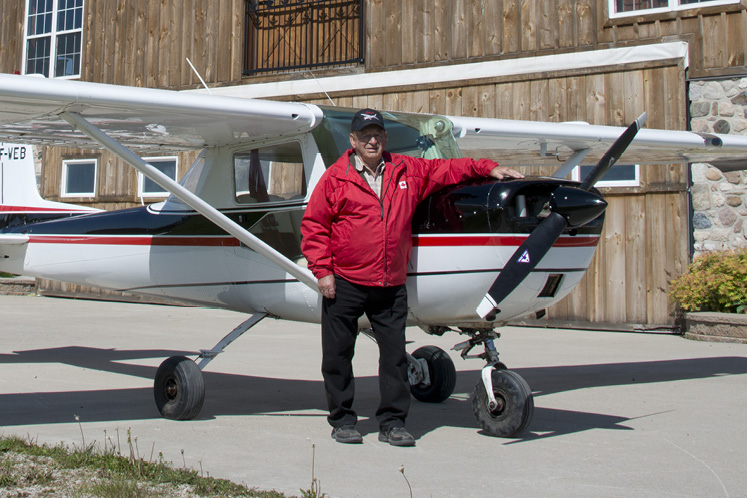
John Black takes his Cessna out “maybe once a week” to inspect his crops and check out the neighbourhood.
He flies his 1964 Cessna 150D, registration CF-WEB, “maybe once a week” to inspect his crops and see what other farmers are doing. “But I’m not always going somewhere,” he says. He flies – they all fly – because they can. They fly for the delight of looking at everything all at the same time, for the freedom, for no traffic, no roads, to be above it all.
The view from above
How does Dufferin County appear from the sky?
From 2,000 feet, Mono, northeast of the low sprawl of Orangeville, presents a diversity of topographies: the dark slash of Hockley Valley, the green upholstered jut of Mono Cliffs Provincial Park and the large splash of Island Lake, visible for miles (though you can’t land a float plane there, except in an emergency).
North of Mono, the land in Mulmur bunches into deep folds, marked by fields and forests. “Horsey country,” Stan calls it. To the west, windswept Melancthon and Amaranth below it are remarkable for their towering wind turbines, each more than 260 feet tall and lazily casting shadows twice their height. But even at that size, the towers “are not a big factor for planes,” says John.
Further west, Grand Valley, cut by the meandering Grand River, is a mosaic of farms. It’s home to a relative preponderance of airstrips, and its westerly roads end raggedly, interrupted by the moody dark green waters and wetlands of massive Luther Marsh. South again, East Garafraxa is likewise a multi-toned patchwork of farmland, with its road grid plainly tilted on a diagonal.
Relics of a different era?
Private airstrips and those who maintain and use them are fading into aviation’s past. Ever-rising costs of land, fuel and maintenance are factors, even for the fairly well-to-do.
In Paul’s opinion, the younger generation going into aviation isn’t much interested in light aircraft. “They know they can go into a program in a college, put out the money – around $100,000 – and at the end of two years they arrive at the doorstep of the big airlines with a multi-engine instrument rating. They’re mostly interested in driving 737s, 727s, all the big iron. Sad, but that’s just the way it is. In my day, in the ’60s and ’70s, a lot of us went into planes like going into motorcycles or boats or snowmobiles.”
Among others, Madill Field (CGV4), southeast of Grand Valley, was closed and allowed to go back to farmland. “I don’t like to see it,” laments John. “It cuts down the places I can go. We have friends with airplanes and we like to drop in to see them. Those fields are getting scarcer.”
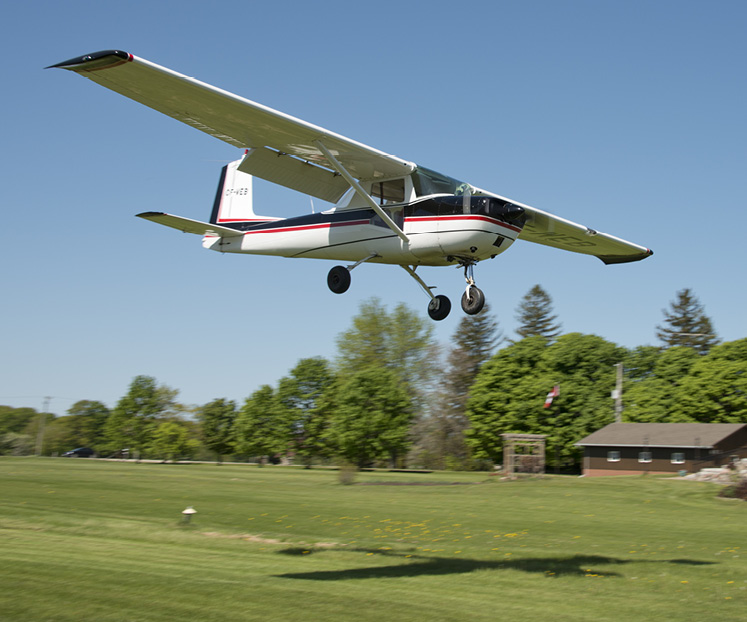
John Black brings his 1964 Cessna 150D in for a landing on the turf runway on his farm in East Garafraxa.
Now well into his 80s, John says, “I’ll never lose interest. As long as you pass the medical every two years (his plane must be inspected and certified annually), you can be flying at 100.” The medical involves stress tests and not-under-stress tests, he adds. “It’s fairly stiff.”
As for Stan and Sheila, they have spent a lifetime and a marriage in the air in small planes. Their most memorable flight, both romantic and frightening, was early on. It was late fall or early winter, and Stan had flown to Sudbury to pick up Sheila, his new girlfriend at the time. The weather forecast over the route back to Brampton wasn’t 100 per cent, he says, but it was favourable for visual sight rules.
“By the time we got to Parry Sound, bad weather had set in. Snow and sleet were sticking to the wings and lift struts. To see, we had to descend until we were about 100 feet above the treetops. There was no airport in Parry Sound. I knew if I flew east I’d pass a heavy double black line – Highway 11. I followed it and landed at Muskoka Airport. Sheila remembers kissing the ground. She probably kissed me.”
Today, the Vander Ploegs’ airfield lies long and slim and green behind their beautifully kept and restored Victorian brick farmhouse. Its backdrop is conifer and walnut woods, some of which they planted to replace trees taken down for the airstrip.
But the couple will soon move on from what Stan calls “the love of our lives.” They plan to sell their home, workshop, hangar and the business, and move to the Collingwood area.
Still, they’re not leaving everything behind. The Piper Cub is going with them. Stan will relocate it to a hangar at the Collingwood Airport (CNY3), where he will also mentor an eager young man, passing on the knowledge of what he calls a “dying art” – the restoration of classic biplanes, such as the storied Tiger Moth.
And Stan and Sheila will continue flying. “We live,” says Sheila, pointing to the sky, “up there.”
You Don't Just 'Wing It'
Your car sits in the driveway. You walk outside, slide behind the wheel, activate the ignition and drive away. But when it’s your light aircraft tethered outside, it’s not so simple. Just ask Stan Vander Ploeg.
For starters, he doesn’t assess the weather just by looking out the window.
He checks with AWS – Aviation Weather Services – for current and forecast conditions along his planned route and over his destination, noting temperature, clouds, atmospherics (fog, etc.), and wind speed and direction, both on the surface and aloft.
Preflight is a verb. A crucial one. He doesn’t want an unforeseen problem at 3,000 feet above sea level.
Starting at the nose and circling the aircraft clockwise, he visually and physically checks every component for airworthiness, wary of letting familiarity lead to complacency.
He checks the propeller for damage. Lifting the engine cowling, he “sumps,” meaning he examines small samples of fuel and fluids for colour and contamination.
With practised concentration, he examines engine components. He tap-tap-taps along the fuselage, assessing structural integrity. He grasps, pokes, rotates and presses, assessing struts, lines, cables, hinges, vents and baffles; finger checks nuts and bolts, fittings and fasteners; manually waggles ailerons, flaps and elevators.
Satisfied, he releases tie-down ropes from loops anchored in sunken concrete, looks up into a bright, cloudless sky, and smiles.
Walkaround has taken 10 minutes.
In the four-seat cabin of the 1948 Stinson 108-3, Stan takes the left front seat, fastening lap and shoulder belts, making sure I do the same as I settle into the right front seat beside him. Canadian air regulations oblige him to indicate all emergency exits to passengers, the same as in an airliner.
A telescoping metal control column topped by a D-shape (the steering wheel) is before him. A matching one juts out at me in the seat beside him. Rudder pedals below his feet are similarly duplicated.
Holding a laminated Before Flight checklist he could probably recite by heart, Stan starts engine run-up and system checks, physically touching each of the many gauges and toggles clustered on the metal arc of the instrument panel while saying each check aloud, even when alone.
“Master switch on … primer in and locked … auxiliary pump on … altimeter set [to 1,665 feet, the height of Grand Valley above sea level] … okay.”
The view over the high nose and through the blur of spinning propeller as he taxis out isn’t great and is further obscured by a central strut dividing the windscreen and two diagonal supporting rods crossing it.
At the end of the airstrip, he turns the plane tightly around to head into the wind. Ahead is a long, seemingly narrow, lawn of mowed turf.
He makes final system checks to a rising racket as he warms the engine. He looks ahead intently, adjusts his headset and sunglasses. And smiles.
Full power! The engine screams and the plane thrusts forward, bouncing from side to side. He appears very calm while seeming – to the uninitiated, at least – to wrestle with the control column and fiddle with an extended twist-push-pull rod mid-dash, which is the throttle.
Amid all the exertions and concentration, we gently lift off the earth. The little plane climbs quickly.
At 2,600 feet (or 1,000 feet AGL – above ground level), he powers back, levelling off and soaring above the astounding patchwork of greens, browns, yellows and aquas carpeting Headwaters.
It’s very beautiful.
Related Stories
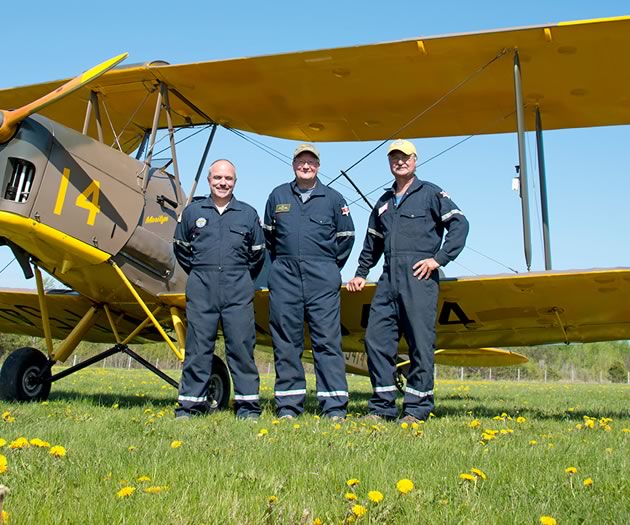
Flight of the Tiger
Jun 17, 2014 | | HeritageFor three vintage aircraft enthusiasts, slipping “the surly bonds of earth” in their restored Tiger Moth was an unforgettable experience.
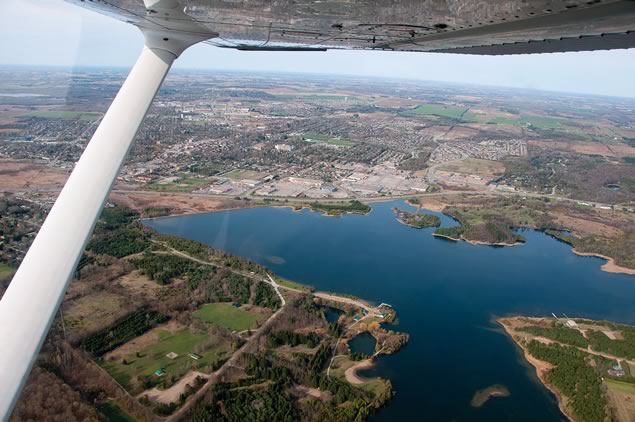
Up, up and away: Brampton Flight Centre offers would-be pilots“three-dimensional freedom”
Jun 19, 2012 | | Back IssuesI was making big swooping manoeuvres, feeling as if I were a kid running across the lawn with my arms outstretched playing airplane.









Inspiring. Enjoyed reading it.
Rajiv Sadana from Brampton on Jul 2, 2023 at 4:50 pm |
That was a thoroughly enjoyable read!
Tim Tolton from Montreal on Jun 24, 2023 at 11:32 am |